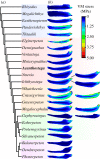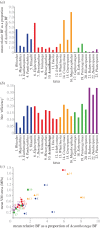Feeding biomechanics in Acanthostega and across the fish-tetrapod transition
- PMID: 24573844
- PMCID: PMC3953833
- DOI: 10.1098/rspb.2013.2689
Feeding biomechanics in Acanthostega and across the fish-tetrapod transition
Abstract
Acanthostega is one of the earliest and most primitive limbed vertebrates. Its numerous fish-like features indicate a primarily aquatic lifestyle, yet cranial suture morphology suggests that its skull is more similar to those of terrestrial taxa. Here, we apply geometric morphometrics and two-dimensional finite-element analysis to the lower jaws of Acanthostega and 22 other tetrapodomorph taxa in order to quantify morphological and functional changes across the fish-tetrapod transition. The jaw of Acanthostega is similar to that of certain tetrapodomorph fish and transitional Devonian taxa both morphologically (as indicated by its proximity to those taxa in morphospace) and functionally (as indicated by the distribution of stress values and relative magnitude of bite force). Our results suggest a slow tempo of morphological and biomechanical changes in the transition from Devonian tetrapod jaws to aquatic/semi-aquatic Carboniferous tetrapod jaws. We conclude that Acanthostega retained a primitively aquatic lifestyle and did not possess cranial adaptations for terrestrial feeding.
Keywords: Acanthostega; feeding; finite-element analysis; fin–limb transition; geometric morphometrics; phylogeny.
Figures



References
-
- Anderson PSL, Friedman M, Brazeau MD, Rayfield EJ. 2011. Initial radiation of jaws demonstrated stability despite faunal and environmental change. Nature 476, 206–209 (doi:10.1038/nature10207) - DOI - PubMed
-
- Pierce SE, Clack JA, Hutchinson JR. 2012. Three-dimensional limb joint mobility in the early tetrapod Ichthyostega. Nature 486, 523–526 - PubMed
-
- Jarvik E. 1952. On the fish-like tail in the ichthyostegid stegocephalians. Medd. Groenland 114, 1–90
-
- Clack JA. 2012. Gaining ground: the origin and evolution of tetrapods, 2nd edn Bloomington, IN: Indiana University Press
-
- Coates MI, Clack JA. 1990. Polydactyly in the earliest known tetrapod limbs. Nature 347, 66–69 (doi:10.1038/347066a0) - DOI
MeSH terms
LinkOut - more resources
Full Text Sources
Other Literature Sources

